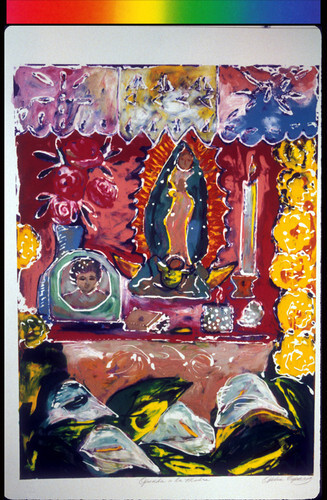Title
Ofrenda A La Madre
Creator
Description
Print depicts a small altar surrounded by papel picado on top, marigolds on the right, and calla lilies on the bottom. Altar is composed of an image of la Virgen de Guadalupe, a framed photograph, roses, a candles, and a sugar skull.
The artist of any work retains all rights to that work. Copyright has not been assigned to the Regents of the University of California. The copyright law of the United States (Title 17, United States Code) governs the making of photocopies or other reproductions of copyrighted material. Under certain conditions specified in the law, libraries and archives are authorized to furnish a photocopy or other reproduction. One of these specified conditions is that the photocopy or reproduction is not to be "used for any purpose other than private study, scholarship, or research." If a user makes a request for, or later uses, a photocopy or reproduction for purposes in excess of "fair use," that user may be liable for copyright infringement. No further reproduction is permitted without prior written permission by the artist or copyright holder. Any requests for permission to reproduce this piece must be directed to: Self-Help Graphics & Art 3802 Cesar E. Chavez Avenue Los Angeles, CA 90063 For further information: (323) 881-6444 Fax: (323) 881-6447 info@selfhelpgraphics.com
Subject
Date
Format
Language
Contributor
Annotation
Ofelia Esparza is internationally recognized for her ofrendas (altars or shrines) that commemorate the dead. For example, in 2018, Esparza received a National Heritage Fellowship from the National Endowment for the Arts. As a sixth-generation altarista (altar-maker), Esparza learned from her mother and grandmother to make ofrendas to honor loved ones who have passed away. She continued the family heritage by teaching her own children. Additionally, Esparza teaches youth in East Los Angeles about the importance of continuing this tradition and builds altares for numerous community organizations, schools, and churches.
Produced at Self Help Graphics and Art, the print shows the numerous elements that signal an offering: a figure of the Virgin of Guadalupe, marigold flowers or cempoalxochitl, roses, candles, papel picado (cut paper), and a framed photo of the commemorated person. Depicting a domestic altar, the image suggests the concept of domesticana, which artist, curator, and scholar Amalia Mesa Bains coined to indicate how Chicana artists reference domesticity to challenge gender norms and celebrate womanhood. (Authors: Karen Mary Davalos with Karen Castellanos)
Produced at Self Help Graphics and Art, the print shows the numerous elements that signal an offering: a figure of the Virgin of Guadalupe, marigold flowers or cempoalxochitl, roses, candles, papel picado (cut paper), and a framed photo of the commemorated person. Depicting a domestic altar, the image suggests the concept of domesticana, which artist, curator, and scholar Amalia Mesa Bains coined to indicate how Chicana artists reference domesticity to challenge gender norms and celebrate womanhood. (Authors: Karen Mary Davalos with Karen Castellanos)
Access Rights
Image is displayed for education and personal research only. For individual rights information about an item, please check the “Description” field, or follow the link to the digital object on the content provider’s website for more information. Reuse of copyright protected images requires signed permission from the copyright holder. If you are the copyright holder of this item and its use online constitutes an infringement of your copyright, please contact us by email at rhizomes@umn.edu to discuss its removal from the portal.
